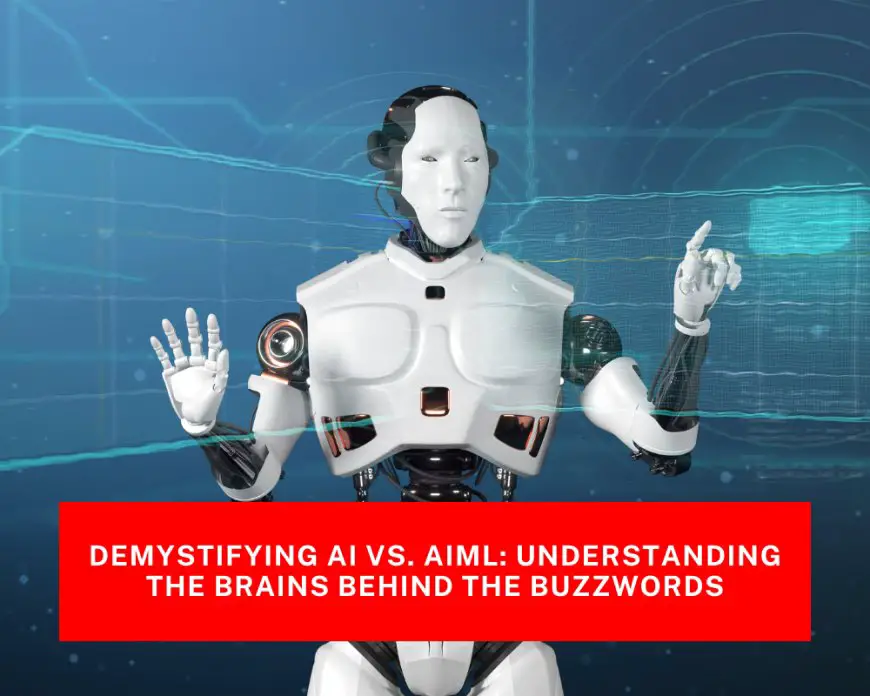Demystifying AI vs. AIML: Understanding the Brains Behind the Buzzwords
Confused by AI and AIML? This blog post breaks down the key differences and explores their roles in shaping the future. Learn about Machine Learning, Natural Language Processing, and more!

Artificial intelligence (AI) has become a ubiquitous term, fueling advancements in everything from self-driving cars to virtual assistants. But within this vast landscape lies a subfield often confused with AI: Artificial Intelligence Markup Language (AIML).
This blog post tackles the key differences between AI and AIML, helping you navigate the world of intelligent machines. Buckle up, and let's dive in!
The Allure of Artificial Intelligence (AI)
AI, in its most basic form, refers to the intelligence exhibited by machines. It encompasses a broad range of capabilities, including:
- Machine Learning (ML): Machines that can learn and improve without explicit programming. Think of facial recognition software getting better at identifying faces with more data.
- Natural Language Processing (NLP): Machines that understand and generate human language. Chatbots that answer customer queries are a prime example.
- Computer Vision: Machines that can interpret and analyze visual information. Self-driving cars rely heavily on computer vision to navigate roads.
- Robotics: Machines that can perform tasks in the physical world. Industrial robots play a vital role in manufacturing.
The goal of AI research is to create machines that can reason, learn, and act autonomously, mimicking or even surpassing human intelligence.
AIML: The Language of Chatbots
While the term "Artificial Intelligence" implies grand ambitions, AIML takes a narrower approach. It's a specific language used to develop chatbots – conversational agents that simulate human interaction.
Here's how AIML works:
- Structured format: AIML scripts consist of patterns (user inputs) and templates (chatbot responses).
- Pattern matching: When a user types a message, the chatbot tries to find a matching pattern in its database.
- Template responses: If a match is found, the corresponding template response is retrieved and displayed to the user.
- Limited flexibility: AIML chatbots lack true understanding of language. They rely on keyword matching and pre-programmed responses.
AI vs. AIML: A Clear Distinction
Now that we understand both AI and AIML, let's dissect the key differences:
- Scope: AI is a vast field encompassing various techniques to achieve machine intelligence. AIML is a specific language limited to building chatbots.
- Learning: AI, particularly through Machine Learning, allows machines to learn and improve from data. AIML chatbots rely on pre-programmed responses and lack true learning capabilities.
- Intelligence: AI aspires to replicate human-like intelligence, including reasoning, problem-solving, and adaptation. AIML offers a basic level of simulated conversation, often lacking true understanding of context or nuance.
- Applications: AI has a broad range of real-world applications, from healthcare to finance to entertainment. AIML is primarily used for customer service chatbots and basic conversational interfaces.
The Future of AI and AIML
AI research is constantly evolving, aiming to develop more sophisticated machines capable of complex tasks. Machine learning plays a crucial role in this advancement, enabling machines to learn from vast amounts of data and adapt to new situations.
While AIML likely won't be leading the charge in groundbreaking AI research, it will continue to have its place. As conversational interfaces become more commonplace, AIML can be a valuable tool for building basic chatbots that handle routine inquiries. However, the future of chatbots might lie in integrating AIML with more advanced natural language processing techniques, allowing for more natural and engaging interactions.
Conclusion
Understanding the difference between AI and AIML is crucial as these technologies continue to evolve. AI holds immense potential to transform our world, while AIML will continue to play a role in powering basic conversational interfaces. By staying informed about these advancements, you'll be better equipped to navigate the future of intelligent machines.
Ready to delve deeper? Explore the vast resources available online to learn more about AI, Machine Learning, and the exciting world of chatbots.








